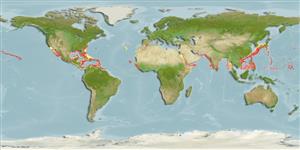Environment: milieu / climate zone / depth range / distribution range
Ökologie
seewasser benthopelagisch; tiefenbereich 128 - 885 m (Ref. 4503), usually 200 - 400 m (Ref. 4503). Deep-water; 38°N - 7°N
Eastern Atlantic: Gulf of Guinea, off Senegal, and off South Africa; reported from Namibia (Ref. 4255). Western Atlantic: Virginia, USA to northern South America (Ref. 7251). Also found in Brazil (Ref. 47377). Western Pacific: Japan, Philippines, New Caledonia, between Fiji and Tonga Islands, Australia (Ref. 7300), New Zealand (Ref. 5755). Indian Ocean (Ref. 47377).
Size / Gewicht / Alter
Maturity: Lm ? range ? - ? cm
Max length : 17.5 cm TL Männchen/unbestimmt; (Ref. 39376)
Rückenflossenstacheln (insgesamt): 5 - 6; Rückenflossenweichstrahlen (insgesamt): 27-30; Afterflossenstacheln 2; Afterflossenweichstrahlen: 27 - 29. Body silvery, with round black spots; anterior pelvic rays and end of caudal fin black (Ref. 4255). First dorsal spine minute, 2nd the longest; 1st anal spine markedly long, subequal to orbit (Ref. 13608). Gill rakers rudimentary.
Found on the continental slope. Benthic species (Ref. 75154). Minimum depth from Ref. 58018.
Life cycle and mating behavior
Geschlechtsreife | Fortpflanzung | Ablaichen | Eier | Fecundity | Larven
Karrer, C., 1990. Grammicolepididae. p. 634-636. In J.C. Quero, J.C. Hureau, C. Karrer, A. Post and L. Saldanha (eds.) Check-list of the fishes of the eastern tropical Atlantic (CLOFETA). JNICT, Lisbon; SEI, Paris; and UNESCO, Paris. Vol. 2. (Ref. 4503)
IUCN Rote Liste Status (Ref. 130435)
Bedrohung für Menschen
Harmless
Nutzung durch Menschen
Fischereien: nicht kommerziell
Mehr Information
NamenSynonymeMetabolismusRäuberÖkotoxikologieFortpflanzungGeschlechtsreifeAblaichenSpawning aggregationFecundityEierEientwicklung
ReferenzenAquakulturAquakultur ProfilZuchtlinienGenetikElectrophoresesVererbbarkeitKrankheitenVerarbeitungNutrientsMass conversion
PartnerBilderStamps, Coins Misc.LauteCiguateraGeschwindigkeitSchwimmstilKiemenoberflächeOtolithsGehirngrößeSehfähigkeit
Tools
Zusatzinformationen
Download XML
Internet Quellen
Estimates based on models
Preferred temperature (Ref.
123201): 9.6 - 19.4, mean 13.3 °C (based on 233 cells).
Phylogenetic diversity index (Ref.
82804): PD
50 = 1.1250 [Uniqueness, from 0.5 = low to 2.0 = high].
Bayesian length-weight: a=0.01905 (0.00917 - 0.03958), b=2.94 (2.75 - 3.13), in cm total length, based on LWR estimates for this species & (Sub)family-body (Ref.
93245).
Trophic level (Ref.
69278): 3.6 ±0.8 se; based on size and trophs of closest relatives
Fishing Vulnerability (Ref.
59153): Low vulnerability (10 of 100).
